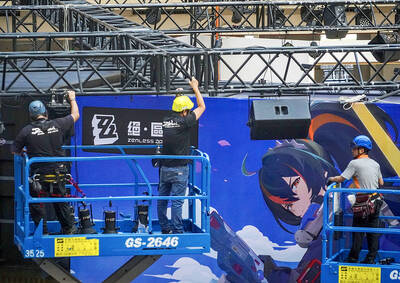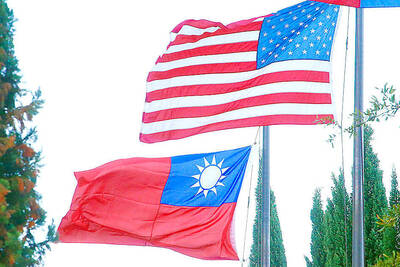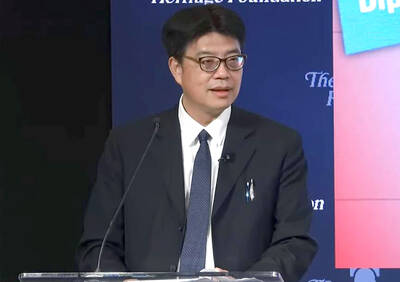Two Chinese military surveillance aircraft were monitored as they flew east of Taiwan yesterday, marking the third time this month that Chinese military planes were detected near the nation, the Ministry of National Defense said.
Two Chinese People’s Liberation Army (PLA) Shaanxi Y-8 aircraft flew northeast through the Bashi Channel to the south, but remained outside of Taiwan’s air defense identification zone (ADIZ), the ministry said.
They later flew over the Miyako Strait, accompanied by two Sukhoi Su-30 fighter jets, before returning to their base in China, it added.
It was the latest in a series of Chinese military activities near Taiwan since last month.
On Wednesday, a Y-8 aircraft was detected flying over the western Pacific Ocean, through the Miyako Strait and into the East China Sea, while on Aug. 5, a group of Chinese Xian H-6K bombers and Y-8 aircraft were seen near Taiwan’s ADIZ.
On July 25, a Xian H-6K bomber flew close to Taiwan’s ADIZ, passing through the Bashi Channel and the Miyako Strait before returning to Chinese airspace, the ministry said.
On July 20, Taiwan scrambled fighter jets as eight H-6K bombers and Y-8 aircraft flew past its east and west coasts, but remained in international airspace.
The Miyako Strait, which lies between the Japanese islands of Miyako and Okinawa, is part of Japan’s exclusive economic zone, but includes a narrow band of international waters and airspace.
The ministry said the maneuvers have been closely monitored.
China has yet to comment on the drills, but its air force has carried out several rounds of long-distance training exercises around Taiwan and southern Japanese islands in recent months.
The frequency at which Chinese military aircraft have been circling the nation is a signal that Beijing intends to make such flights routine, National Taiwan University associate professor of political science Chen Shih-min (陳世民) said yesterday.
It should be expected that Chinese aircraft are to inch closer to the nation’s ADIZ and some might begin gathering intelligence, he said, adding that the PLA judges that Taiwan cannot counter the flights, as military action is considered an outright impossibility.
The flights also serve to show the PLA’s ability to conduct operations within its sovereign claims at will and convince the world that Taiwan is a part of China, he added.
Beijing might believe that the cross-strait political climate gives it no other option to pressure Tsai Ing-wen’s (蔡英文) administration than to show force, he said.
Although Beijing did not find such measures necessary during former president Ma Ying-jeou’s (馬英九) administration, it could be concerned that given time, the nation’s continued independence might become a fait accompli, he said.
Any development in that direction would bode ill for Chinese President Xi Jinping (習近平) at a time when the National Congress of the Chinese Communist Party (CCP) is close at hand, Chen said.
Internal struggles are flaring up ahead of the congress and Xi might have sought to relieve pressures from the hawkish factions through an ostentatious display, Chen said.
The government must register a protest with the international community against any further provocations from Beijing to remind other nations of the situation’s gravity, he said.
Additional reporting by Reuters

Taiwan is projected to lose a working-age population of about 6.67 million people in two waves of retirement in the coming years, as the nation confronts accelerating demographic decline and a shortage of younger workers to take their place, the Ministry of the Interior said. Taiwan experienced its largest baby boom between 1958 and 1966, when the population grew by 3.78 million, followed by a second surge of 2.89 million between 1976 and 1982, ministry data showed. In 2023, the first of those baby boom generations — those born in the late 1950s and early 1960s — began to enter retirement, triggering

ECONOMIC BOOST: Should the more than 23 million people eligible for the NT$10,000 handouts spend them the same way as in 2023, GDP could rise 0.5 percent, an official said Universal cash handouts of NT$10,000 (US$330) are to be disbursed late next month at the earliest — including to permanent residents and foreign residents married to Taiwanese — pending legislative approval, the Ministry of Finance said yesterday. The Executive Yuan yesterday approved the Special Act for Strengthening Economic, Social and National Security Resilience in Response to International Circumstances (因應國際情勢強化經濟社會及民生國安韌性特別條例). The NT$550 billion special budget includes NT$236 billion for the cash handouts, plus an additional NT$20 billion set aside as reserve funds, expected to be used to support industries. Handouts might begin one month after the bill is promulgated and would be completed within

NO CHANGE: The TRA makes clear that the US does not consider the status of Taiwan to have been determined by WWII-era documents, a former AIT deputy director said The American Institute in Taiwan’s (AIT) comments that World War-II era documents do not determine Taiwan’s political status accurately conveyed the US’ stance, the US Department of State said. An AIT spokesperson on Saturday said that a Chinese official mischaracterized World War II-era documents as stating that Taiwan was ceded to the China. The remarks from the US’ de facto embassy in Taiwan drew criticism from the Ma Ying-jeou Foundation, whose director said the comments put Taiwan in danger. The Chinese-language United Daily News yesterday reported that a US State Department spokesperson confirmed the AIT’s position. They added that the US would continue to

IMPORTANT BACKER: China seeks to expel US influence from the Indo-Pacific region and supplant Washington as the global leader, MAC Minister Chiu Chui-cheng said China is preparing for war to seize Taiwan, Mainland Affairs Council (MAC) Minister Chiu Chui-cheng (邱垂正) said in Washington on Friday, warning that Taiwan’s fall would trigger a regional “domino effect” endangering US security. In a speech titled “Maintaining the Peaceful and Stable Status Quo Across the Taiwan Strait is in Line with the Shared Interests of Taiwan and the United States,” Chiu said Taiwan’s strategic importance is “closely tied” to US interests. Geopolitically, Taiwan sits in a “core position” in the first island chain — an arc stretching from Japan, through Taiwan and the Philippines, to Borneo, which is shared by